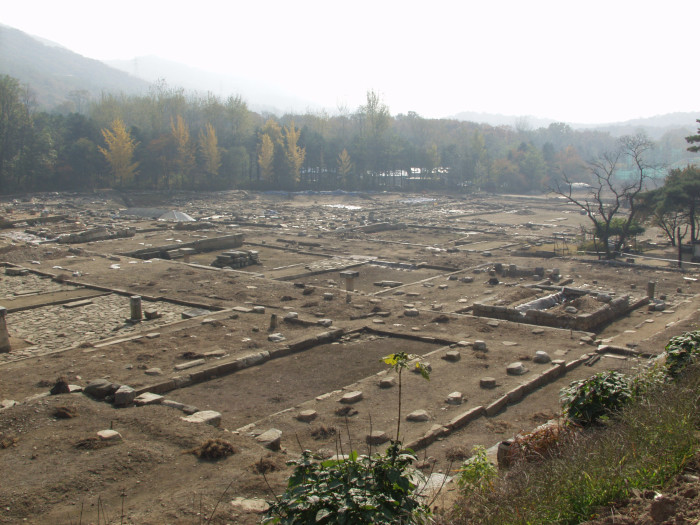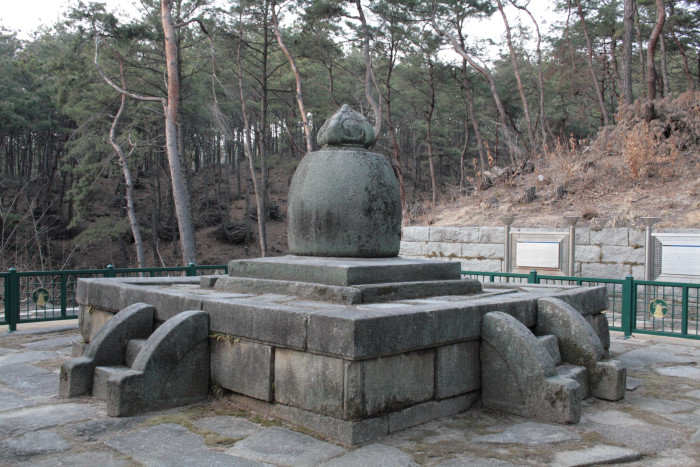GyeongGi Cultural Properties
4. Buddhist Temples in Gyeonggi, Home of Goryeo Buddhism
Goryeo (918-1392) was a Buddhist nation. Wang Geon (877-?, r. 918-943), the founder and the first king of the Goryeo Dynasty, left the Ten Injunctions (Hunyosipjo) for his successors. He declared that "all of the major state tasks should be dependent on the divine protection provided by the Buddha," and had his royal descendants keep the tradition of holding the Festivals of Lotus Lanterns (Yeondeunghoe) and the Eight Gates (Palgwanhoe). He proposed the Protection of Dharma, or Buddha's Law, as the base for the safety and prosperity of his kingdom.
A Panorama of the Godalsa Temple Site in Yeoju / Provided by Professor Jang Il-gyu |
It was one year after the foundation of Goryeo when its founder Wang Geon made Gaegyeong the capital of his dynasty. He then established in the capital around ten Buddhist temples, including Beobwangsa and Wangnyunsa, and more, including Jungheungsa and Sammaksa, near Bukhansan and Gwanaksan mountains. A group of eminent Seon (Chan or Zen) monks who supported Wang Geon during the early phase of the new dynasty, such as Chanyu, Yeoyeom and Gyeongbo, also established or renovated temples, including Godalsa, Yongmunsa, Sanasa, and Hoeryongsa, around the Namhangang River leading to the capital of the newly established dynasty. Of them, the Bongeopsa Temple was famous as one of several temples enshrining the portrait of the dynasty founder.
The unification of the Later Three Kingdoms by Goryeo in the early tenth century coincided with the unity between two major Buddhist schools, the text-based Gyo School and the meditation-based Seon School. Of the temples established during this period, the Cheongdamsa Temple, one of the ‘Ten Avatamsaka Mountains’ mentioned by the great Silla scholar Choe Chi-won (857-?); the Janguisa and Bongseonsa Temples, connected with the Seon monk Tanmun who united the Gyo and Seon schools of Buddhism; and the Dobongsa Temple, established by Hyegeo (899-974), who was also connected with the Geumsansa Temple in Gimje and Mireuksa Temple in Iksan, represent the development of the Avatamsaka Sect (Hwaeomjong) and the Dharmalaksana Sect (Beopsangjong) that thrived in Gyeonggi-do.
The harmony of the Gyo and Seon Schools in the tenth century led King Gwangjong (r. 949~975), the fourth ruler of the Goryeo Dynasty, to the decision that the Tripitaka, the entire collection of the Buddhist canon, should be stored in three temples, Godarwon, Huiyangwon, and Dobongwon, for future generations. Today, no traces remain to indicate the location of Dobongsa Temple, but the Godalsa Temple, built on an area of about 144 square kilometers and originally accommodating several hundred monks, is represented by a massive Buddhist pedestal, known to be one of the largest of its kind in Korea today, and a large stupa lavishly ornamented with elaborate carvings still remaining on the temple site. These historic temples in Gyeonggi-do received special attention and support from the royal family of Goryeo even from the early stage of the dynasty.
In the 11th century, the Buddhist temples in Gyeonggi-do increased their influence, spreading it widely to the neighboring areas. One of the leading figures of the period, Jeonghyeon (972-1054), for instance, founded the Chiljangsa Temple, and transmitted the teachings of the Dharmalaksana Sect, represented by the Samcheonsa and Dobongsa Temples, to the Hyeonhwasa Temple in Gaegyeong, and later to Haerin of the Beopcheonsa Temple in Wonju, Sohyeon of the Geumsansa Temple in Gimje, Yi Ja-yeon of the Inju Yi Clan, and Dosaeng, a son of King Munjong (r. 1046-1083). In the meantime, Nanwon, a son of Kim Eun-bu from the Ansan Kim Clan, transmitted the teachings of Avatamsaka and Cheontae Buddhism to Uicheon (1055-1101), another son of King Munjong; Jingeom, a son of King Sukjong (r. 1095-1105); and Deokso, a son of King Injong (r. 1122-1146). History shows that the Buddhist temples in Gyeonggi during the Goryeo Period continued to play a leading role in the development of Buddhism under the patronage of the Goryeo court.
A Panorama of the Hoeamsa Temple Site in Yangju / Provided by Professor Jang Il-gyu |
The rise of the military regime in Goryeo and the following invasion of the Mongol forces in the 13th century led to the destruction of many temples across Gyeonggi. The unification of Gyo and Seon schools and the harmony between Buddhism and Confucianism in the following period resulted in the foundation laid for the revival of Buddhism which was accelerated by the establishment of Hyeondeungsa and Bogwangsa Temples by Jinul (1158-1210) and his pupil, Seunghyeong. In the following 14th century, two great Buddhist leaders, Jigong and his pupil Naong, renovated Hoeamsa Temple, making it the head of all Buddhist temples in the country and the powerhouse for the revival of Buddhism in the province of Gyeonggi. The establishment and growth of Hoeamsa Temple helped two monks, Hyegeun and Bou, establish and renovate Cheongnyongsa and Taegosa Temples. Another Buddhist leader, Jacho, also played an important role in the development of Buddhism in the province by renovating Hoeryongsa and Bogwangsa Temples and the publication of the Tripitaka at Silleuksa Temple.
Stone Bell of Bojejonja in Silleuksa Temple, Yeoju / Provided by Professor Jang Il-gyu |
The influence of Buddhism in Gyeonggi upon the rest of the country grew significantly during the early Goryeo period when two eminent monks, Bou and Hyegeun, established close relations with the Sanasa and Godalsa temples. In the later Goryeo Period, King Gongmin (r. 1351-1374) renovated the Bongeopsa Temple, contributing to the restoration of the prosperity the Buddhist temples in Gyeonggi relished during the reign of King Taejo, the founder of the Goryeo dynasty. The Buddhist communities in the province also played an important role in connection with Yi Seong-gye when he founded the Joseon Dynasty in 1392.
Korean Buddhism in the Goryeo Period is generally represented by the Tripitaka Koreana and altar paintings. While only remnants are left of most of the Goryeo temples in Gyeonggi, geopolitical studies of the remaining heritage are needed to reveal the role that they played in the development of Korean Buddhism. / ◎Jang Il-gyu (Research Professor, Dongguk University)
<Copyright(c)2002 GGC All rights reserved.>


